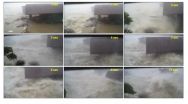(Press-News.org) Researchers from the International Research Institute of Disaster Science (IRIDeS) at Tohoku University in Sendai, Japan, have been looking into how tsunami-type waves can originate from massive storm systems, independent of earthquakes or landslides.
According to Volker Roeber and Jeremy D. Bricker, massive storm systems can be the cause of devastating tsunami-type waves. It happened during Typhoon Haiyan, which struck the Philippines in November 2013. Typhoon Haiyan was one of the strongest typhoons ever recorded, causing more than 6,000 casualties.
A development aid worker caught a scene on video where a wave devastated parts of a small fishing village (see Fig. 1). The wave swept away entire houses and was reminiscent of the tsunami waves that followed the Great East Japan Earthquake in 2011.
Roeber and Bricker have investigated the generation and characteristics of this phenomenon and have found a surprisingly simple explanation called "surf beat."
As waves travel in the open ocean, their wavelength determines the propagation speed. Longer waves overtake shorter ones and the superposition of multiple waves leads to the formation of wave groups, often referred to as "sets." The wave groups can be considered as an additional long wave component embedded in the sea state and bound by the storm waves.
Offshore of the wave breaking zone, the long wave component is not directly visible because it is very long and superimposed by other short waves. "The long group waves can have wavelengths of several kilometers but their height is much lower than that of the individual storm waves. This is similar to what characterizes nearshore tsunamis," explains Roeber.
As the wave groups approach shallow areas, they break and transport water onshore. Consequently, the accumulated water level pulsates with the wave groups. This is what's called the "surf beat" and it can be observed at many beaches worldwide.
While a surf beat is usually harmless and goes unnoticed, it had a devastating impact on the town of Hernani during Typhoon Haiyan. What's more surprising is that Hernani is located behind a 0.5 km wide fringing reef, which should have protected it. "Until now, we have believed that reefs serve as a reliable protection from storm waves", says Bricker. "But during Haiyan, the opposite seemed to have happened."
It turned out that the steep slope of the reef that leads towards the open ocean allows for only a very short wave-breaking zone. When waves break, they dissipate energy. But over the steep reef slope, the breaking process affected mostly the short storm waves.
In contrast, the long group waves, which form the surf beat, were able to keep almost all of their energy. These waves propagated freely over the reef flat and even steepened at the beach into a turbulent breaking wave, which destroyed the town's seawall and many houses behind it.
"We computed this tsunami-like wave with our numerical models and found its energy to be very similar to waves from past tsunamis in the Pacific," says Roeber.
In addition, the researchers state that the Hernani wave was not a worst-case scenario. If the period of the group waves had been in sync with the natural oscillation period of the fringing reef, the wave would have amplified due to resonance and could have been even more destructive. This scenario would have occurred if the reef had been about half as wide.
As Typhoon Haiyan showed, tropical storms not only cause devastation due to strong winds. In coastal areas they also cause flooding from storm surges.
A storm surge is an abnormal increase in the local sea level. It is mainly driven by the wind - which pushes water landward - and the low pressure of the storm that causes the water to arch like a convex lens. A storm surge can flood low-lying coastal areas similar to an extremely high tide level.
In general, disaster management agencies determine coastal flood hazard zones based on studying the storm surge inundation. In most countries, this is currently done by using computer models. However, the conventional storm surge models neglect the important dynamics of the individual storm waves, which is a plausible explanation for the destruction at Hernani.
"The storm surge models do a great job for what they were designed for, but they simply cannot account for the phenomena such as what we have seen in Hernani," says Bricker. Both researchers therefore think that it is necessary to additionally utilize a new generation of models that resolve individual waves for hazard mitigation purposes.
"We have developed accurate and powerful numerical tools which are able to compute these dangerous tsunami-type waves," says Roeber. He especially recommends that the flood maps for coastal communities sheltered by fringing reefs should be re-assessed. This includes many islands in the tropical and sub-tropical latitudes that have experienced strong storms in the past, such as Okinawa and Hawaii.
"Tsunami-like waves such as the one in Hernani will happen again," he says. "But we now can be better prepared."
INFORMATION:
Publication details:
Title: Destructive tsunami-like wave generated by surf beat over a coral reef during Typhoon Haiyan.
Authors: Volker Roeber, Jeremy D. Bricker
Journal: NATURE COMMUNICATIONS | 6:7854 | DOI: 10.1038/ncomms8854
http://www.nature.com/naturecommunications
Contact details:
Volker Roeber
International Research Institute of Disaster Science, Tohoku University
Tel: +81-22-752-2088
Email: roeber@irides.tohoku.ac.jp
Jeremy D. Bricker
International Research Institute of Disaster Science, Tohoku University
Tel: +81-22-752-2088
Email: bricker@irides.tohoku.ac.jp
People who recognise they are overweight or obese are more likely to put on weight than those who are unaware that they may be heavier than doctors would advise, according to research by the University of Liverpool.
In a study, published in the International Journal of Obesity, researchers looked at the lives of 14,000 adults in the US and the UK through data captured in three studies: the US National Longitudinal Study of Adolescent to Adult Health, the UK National Child Development Study and Midlife in the United States.
They analysed data from time periods after ...
Lack of microinvaginations in the cell membrane, caveolae, can cause serious diseases such as lipodystrophy and muscular dystrophy. Researchers at Lund University in Sweden have now discovered a "main switch" that regulates the formation of these invaginations.
Many cells in the body are equipped with small microinvaginations in the cell membrane called caveolae. They are important for the cell's ability to take up molecules and particles from the cell surface into the cell. If this doesn't work, the function of the cell is disturbed, resulting in diseases. Having too ...
New camera technology that reveals the world through the eyes of animals has been developed by University of Exeter researchers. The details are published today in the journal Methods in Ecology and Evolution.
The software, which converts digital photos to animal vision, can be used to analyse colours and patterns and is particularly useful for the study of animal and plant signalling, camouflage and animal predation, but could also prove useful for anyone wanting to measure colours accurately and objectively.
The software has already been used by the Sensory Ecology ...
Dasabuvir (trade name Exviera) and the fixed-dose drug combination ombitasvir/paritaprevir/ritonavir (trade name Viekirax) have been available since January 2015 for the treatment of adults with chronic hepatitis C infection. The German Institute for Quality and Efficiency in Health Care (IQWiG) had examined their added benefit in a dossier assessment completed in April 2015.
In an addendum, the Institute now assessed study data subsequently submitted by the drug manufacturer in the commenting procedure. According to the findings, the results of an indirect comparison ...
Why some planets, like Saturn or Jupiter, have their rings, while others like, the Earth or Mars do not? It turned out that "the size does not matter" -- not only giants as Saturn possess the rings, but even tiny asteroids do: According to the recent discovery of the Spitzer Space Telescope, the remote asteroid Chariklo, which is only 260 km in diameter, also has rings.
A natural answer may be the following: Occasionally, in a far past, some planets had much more material in their vicinity then the other ones. The material was in a form of dust. Dust particles merged ...
UC Davis study should help guide patients and their oncologists
(SACRAMENTO, Calif.) -- Combing data collected on thousands of California ovarian cancer patients, UC Davis researchers have determined that almost one-third survived at least 10 years after diagnosis.
The unprecedented findings upend the notion that women diagnosed with cancer of the ovary always face a poor chance of survival. In fact, while the study confirmed earlier findings on characteristics associated with ovarian cancer survival -- younger age, earlier stage and lower grade tumors at diagnosis ...
The dull black plastic of the device on Joshua Pearce's desk belies its usefulness. Pearce picks up the box, which has a switch on the side and a small opening on top. A handful of vials sit in a bag nearby, and each would fit snugly in the opening. The set-up seems generic, even bland, except that it could radically change how we deal with water quality issues.
Pearce, who has a joint appointment as an associate professor of materials science and engineering as well as electrical and computer engineering, runs an open sustainability technology lab at Michigan Technological ...
COLLEGE STATION - Woody plant encroachment is one of the biggest challenges facing rangelands worldwide, but it consistently has been under-measured and poorly understood, said a Texas A&M AgriLife Research scientist in College Station.
Dr. Matthew Berg, an AgriLife Research postdoctoral research associate in the Texas A&M department of ecosystem and science management, is trying to change both the understanding and measurement with his latest study, which was captured in the July issue of the Rangeland Ecology and Management publication, http://bit.ly/1JK8JhU.
Berg ...
Accurately forecasting future electricity needs is tricky, with sudden weather changes and other variables impacting projections minute by minute. Errors can have grave repercussions, from blackouts to high market costs. Now, a new forecasting tool that delivers up to a 50-percent increase in accuracy and the potential to save millions in wasted energy costs has been developed by researchers at the Department of Energy's Pacific Northwest National Laboratory.
Performance of the tool, called the Power Model Integrator, was tested against five commonly used forecasting ...
Fundamental differences between how the brain forms during adolescence have been discovered in children with schizophrenia and their siblings, a new study shows.
The study opens up new avenues for researchers to explore when developing treatment for the illness, which can be hugely debilitating for children.
Researchers from the University of Melbourne and the National Institute of Mental Health in Washington DC used structural brain magnetic resonance imaging (MRI) to map the brains of 109 children with childhood-onset schizophrenia (COS), from ages 12 to 24.
They ...




